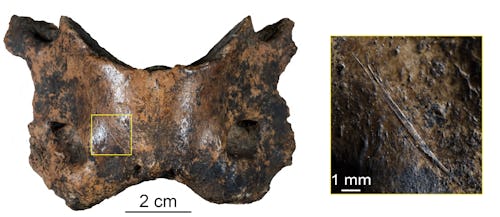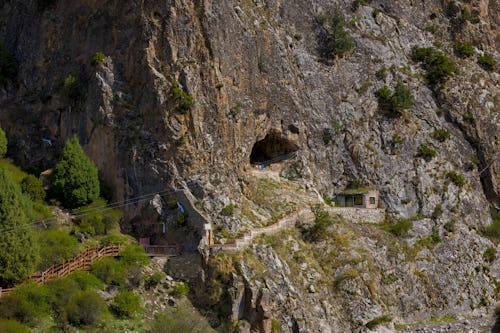
New research sheds light on a mysterious link in the web of human evolution.
We don’t know much about Denisovans, a group of ancient hominins that overlapped with both Neanderthals and our own species (Homo sapiens). For instance, we don’t know what Denisovans looked like because we don’t have anything close to a complete skull specimen (though scientists have made some DNA-informed guesses). We know they lived in certain locations in what’s now Asia, but don’t know the full extent of where they roamed. We know they probably died out between 20,000 and 50,000 years ago, but why is unclear.
Now though, we know a little bit more about what Denisovans ate and how they survived amid the especially harsh conditions of the Tibetan Plateau. The archaic humans butchered a diverse array of animals for food, skins and furs, and tool-making materials inside a cave that they occupied for tens of thousands of years, according to a study published July 3 in the journal Nature. The varied findings described in the new paper shed light on the habits and long-term survival of an extinct, enigmatic relative that shaped modern humans’ genetics.
Baishiya Karst Cave is more than half a mile long and sits at 10,761 feet above sea level on the northeastern edge of the Tibetan Plateau. In 1980, a Buddhist monk meditating in the cave found a human jawbone holding unusually large back teeth. In 2019, protein analysis of that jawbone, dubbed the Xianhe mandible, revealed it was about 160 thousand years old and almost certainly belonged to a Denisovan. Physical remains of Denisovans are scant, and the Xianhe mandible is the largest, most complete Denisovan fossil ever discovered. Follow-up studies documented deposits of Denisovan DNA at the same site.

In the newly published study, archaeologists uncovered another Denisovan bone, new to us modern humans. They unearthed a hominin rib bone, which protein analysis indicates is of the Denisovan lineage. Based on the soil depth and layer where the rib was found, the researchers date it to between 48,000 and 32,000 years ago — a time when modern humans were spreading across Eurasia, which aligns with the timeline of past DNA findings.
Yet, unlike many past studies, the researchers also looked beyond the Denisovan specimens at Baishiya Karst Cave, and delved into the trove of other fossil remnants contained within layers of the site’s soil. They found thousands of fossilized bones and teeth from ancient animals — many of which show signs of human processing. Small cuts, dents, and repetitive chips tell the story of ancient hominins scraping, stripping, and butchering animal carcasses to glean meat, marrow, and hides. In three instances, the scientists recovered what they describe as tools made from animal bone along with one other tool made from a horse tooth.
“Current evidence suggests that it was Denisovans, not any other human groups, who occupied the cave and made efficient use of all the animal resources available to them throughout their occupation,” said Jian Wang, one of the co-lead study authors and a researcher at Lanzhou University in China, in a press statement.
In total, the paleoanthropologists analyzed more than 2,500 bone pieces found across nine stratigraphic units that span between about 190 to 30 thousand years ago. By analyzing trace amino acid sequences held in collagen, they were able to identify the animal origins of about 2,000 of those small specimens. The fossil fragments represent a diverse array of taxa including birds, rodents, carnivores, and herbivores. Among the groups represented were long-extinct woolly rhinos, wolves, foxes, hare, eagles, horse, yak, deer, gazelle, snow leopard, weasels, and spotted hyena. Yet the most common type of animal represented in the collection was the blue sheep or bharal (Pseudois nayaur), a type of caprine that’s still common in the high Himalayas today.
More than 19 percent of all the collected animal bones showed evidence of human activity, while about 20 to40 percent of the sheep and goat specimens carried signs of Denisovan damage. In comparison, less than 1 percent of the collected and identified fossils had rodent or carnivore damage, indicating that Denisovans lived in the cave for a long time and brought most of the animal carcasses to the site.
“The diverse species identified partly answers the questions why Denisovans chose to live in Baishiya Karst Cave and the surrounding Ganjia Basin, and how they survived there” for so long, said Dongju Zhang, another of the lead study authors and an archeologist at Lanzhou University, in the press release.
Clearly, the region provided the ancient humans with a steady and diverse stream of animals to eat and use– even through two different ice ages. It is “reasonable to assume'' that Densioans lived in Baishiya Karst Cave from around 167,000 years ago to 40,000 years ago– and possibly from more than 224,000 to 32,000 years ago, according to the study.
Altogether, the findings offer a clearer portrait of one of our distant relatives. But they also create more questions. If Baishiya Karst Cave and the surrounding environment were such a good place to be for so long, then what changed and why? What prompted the disappearance of Denisovans from the site’s fossil record remains a mystery for another study.
FTTT

0 Comments